Nervous System 1
| Psychopharmacology |
Drug Abuse
How it Works
To be able to understand how psychopharmaca works (the pharmaca that effect our brains thereby influencing the mind), it is necessary to have some insight into the structure of the brain.
So, first something about the brain.
The brain is often compared to a computer.
One common denominator is, for example, that in both information processing systems the information is sent by electrical impulse.
However, the elements that make up a computer are connected to each other: the computer is a continuous system.
Our brain, on the other hand, is made up of nerve cells, neurons, which are not connected to each other: our brain is discontinuous.
The brain has about 10,000,000,000 of these neurons as well as many more supporting cells, called glial cells.
Each nerve cell is connected to approx. 10,000 others and together they form a network which makes even the most advanced supercomputer seem a mere rudiment.
Neurons consist of a cell body with a long process (called an axon) that makes contact with the dendrites of other neurons. See fig. 1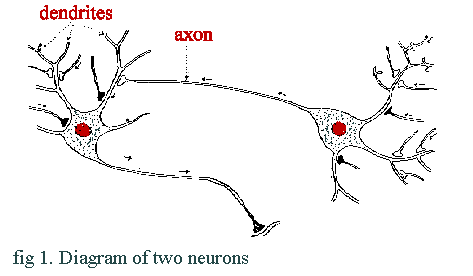
What is special about neurons is that there is a potential difference between the inside and the outside of the cell resulting from differences in the concentration of the sodium ions and the potassium ions.
The chief extracellular ion is sodium, the chief intracellular ion, potassium.
Disruption of this pattern results in a change in the potential difference.
This disruption rushes like a wave along the surface of the neuron. This disrupted conduction is called an action potential. Action potentials are conducted along the long processes of the neurons, the axons, and transfer messages in this way. When an action potential reaches the end of the axon, an impulse does not jump over to the dendrite, but releases a chemical stored in a little sac at the end of the axon.
This chemical, a neurotransmitter, passes the presynaptic membrane, pushes through the narrow cleft between the axon and the dendrite of the next neuron, the synaps, and reacts with special molecules in the cell wall of the next neuron.
These molecules are receptors located in the postsynaptic membrane.
Each nerve cell has about 10,000 synapses, a number of which are always active.
This activity continually causes such disturbances in that tension difference. In each case when the result of all these disturbances go beyond a specific limit, the neuron generates a new action potential which is then transmitted along the process of that cell to the next synapses.
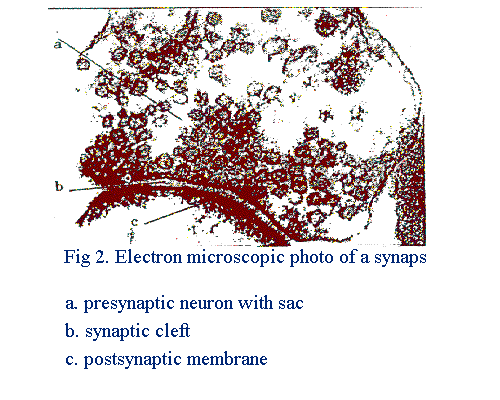
After the neurotransmitter has 'opened the gates', it is thrust from the receptor and either broken down or taken up again in the axonal terminal for re use.
This latter process is called re uptake.
Chemicals that block re uptake intensify the effect of the neurotransmitter because they remain in the synaptic cleft and continue to stimulate the receptors.
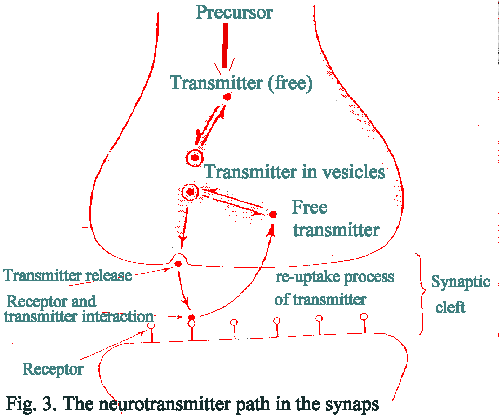
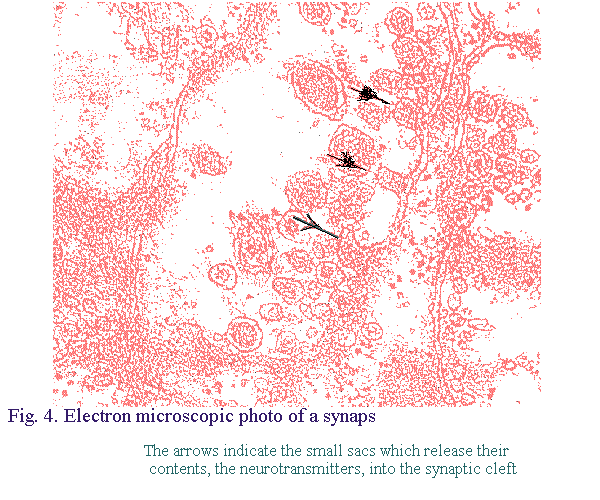 The neuron is, thus, a kind of small calculator that can only add (if the imbalances reinforce each other) or subtract (if the imbalances work against each other) and in this can be compared with a transistor in a computer.
The neuron is, thus, a kind of small calculator that can only add (if the imbalances reinforce each other) or subtract (if the imbalances work against each other) and in this can be compared with a transistor in a computer.
An example might clarify this process.
Everyone knows about the kneejerk reflex: a tap on the knee tendon makes a bent knee contract. The underlying mechanism is that the hammer tap on the knee tendon stimulates a signal in that tendon whereby one or a series of action potentials are passed on along the nerve to a synaps in the spinal cord.
The neurotransmitter released there stimulates another neuron whose process sends the action potential to the upper leg muscles which then contract and extend the leg.
Although it is easy for the doctor to elicit this reflex, it is difficult to elicit in oneself.
This is because the concentration needed by an individual to elicit the reflex is also in the form of a series of opposing action potentials originating from the cerebellum, traveling along this same spinal cord cell and canceling the effect of the action potentials from the knee tendon nerve; no, or very few action potentials get to the upper leg muscles, the leg remains bent.
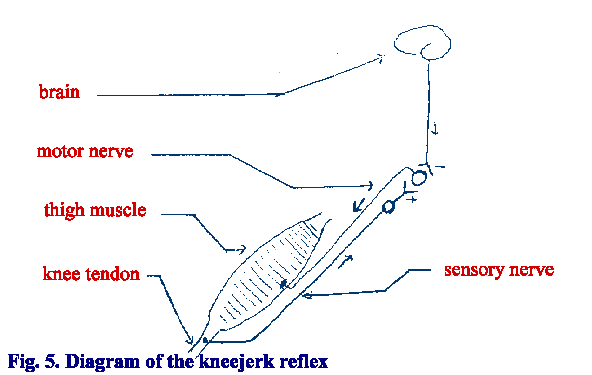
That communication between neurons is a result of the release of chemicals was possibly first put forward by the British physiologist Thomas Elliot in 1905, but pointers were discovered by Otto Loewi in 1921.
He put a frog's heart in a salt solution which kept it beating, and let the fluid flow through a second frog's heart. He then stimulated the first heart's nervus vagus, the nerve that slows down the heart. As expected, the heart started beating slower, however, quite unexpectedly the second heart also started beating slower without stimulation of the nervus vagus of that heart.
So a chemical must have been released from the nervus vagus of the first heart which combined with and influenced the perfusion fluid in the second heart. This chemical was later identified by Sir Henry Dale as acetylcholine.

As mentioned earlier, the reaction between neurotransmitter and receptor is very specific.
Initially it was thought that there were only several neurotransmitters; acetylcholine and a number of organic ammonia compounds, the biogenic amines: adrenalin, noradrenalin, serotonin, dopamine and histamine.
Then it seemed that a number of amino acids (the building blocks of proteins) also function as neurotransmitters of which gamma amino butyric acid and glycine are the most important.
Finally, in the Seventies it became clear that a number of peptides (small amino acid chains) also fulfilled this function.
More than thirty chemicals have by now been identified as neurotransmitters and many more are expected to be identified.
There are also chemicals that do not function directly as neurotransmitters, but influence the working of the neurotransmitters (the neuromodulators) by their effect on e.g. neurotransmitter metabolism.
Finally, it is possible that nerves also separate chemicals that do not end up in a synaptic cleft but in the blood or in the free extracellular space and then act as a hormone.
All psychopharmaca have their effects because they influence neurotransmission by the synapse in some way. They can do this in various ways.
First the production, the synthesis, of theneurotransmitter can be stimulated by administering its building blocks.
Next, the neurotransmitter is stored (storage) in small sacs. Drugs can have an effect on this; the most clear example here is the drugs that break open the sacs that protect the transmitter against enzymes which are breaking down, so that these enzymes destroy the transmitter and the effect of the neurotransmitter concerned is lost.
The third phase is separation in the synaptic cleft: the release. Some drugs enhance separation or have the opposite effect and inhibit it, which results in either an increased or reduced effect.
The fourth phase is stimulation of the receptor: psychopharmaca often imitates the neurotransmitter by stimulating the receptors itself.
After having stimulated the receptor, the neurotransmitter returns to the synaptic cleft.
Two things can happen here: either enzymatic breakdown of the neurotransmitter or re uptake takes place.
In re uptake, the neurotransmitter molecules are taken up again by the presynaptic neuronfor re use. Drugs can either enhance or block both breakdown and re uptake.
Finally, there are drugs that interfere with the intracellular mechanism after stimulation by a neurotransmitter, thereby blocking or enhancing the effect. This is then manipulation ofthe post receptor mechanisms.












